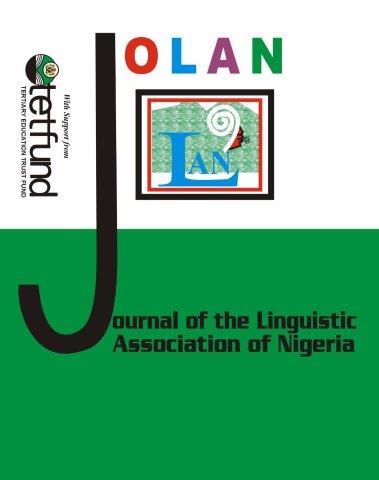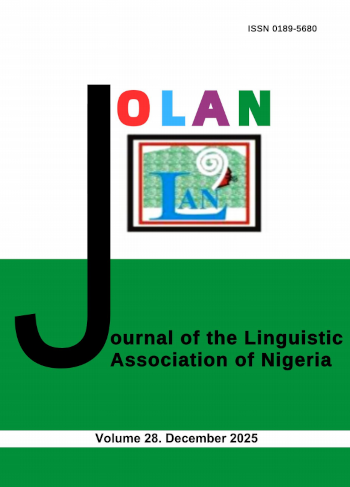Eggon Language Counting System and Derivational Processes
Keywords:
Eggon language, numerals, derivationAbstract
The paper presents Eggon numerals in their order of occurrence, explaining the computation and derivation processes involved using descriptive method. The writer’s intuitive knowledge of the language and a review of previous works on Eggon numerals constitute a major source of data for this paper. The study reveals four types of numerals- cardinals, ordinals, distributives and adverbials (times). The cardinal numerals are classified into basic and derived. The basic numerals which are àkyèn ‘1’, àhà ‘2’,àtrà ‘3’, ènyῖ ‘4’, à tnò ‘5’, efì ‘6’, à fohà ‘7’,à fotè‘8’, à tronyè ‘9’, èk’pò‘10’, ènd’gà ‘100’, and èzbì ‘1000’ are used to derive the secondary numerals using the arithmetic principles of addition and multiplication, on the one hand, and the linguistic phonological, morphological, and syntactic processes of vowel elision, tone change, compounding, sentential expressions on the other. The ordinals are derived using the prefix ba before the respective cardinal number except ̀ori ̀ ‘first’ which has a distinct word. Similarly, the adverbials are also derived using the prefix engyi, while the distributives are produced by partial reduplication in a triplicate form. It can be said that Eggon is a decimal language that is it counts in multiples of ten.
References
Anagbogu, P. (2006). The numerical system of Koring : An analysis.Awka, Journal of Linguistics and Languages (AJILL), 2.71-75.
Anzaku, U. (2006).Eggon- eyi’nyeengla-akpabaori. Jos: Sky Production.3-5.
Atoyebi, J. (n.d). Retrieved March 9, 2013.Oko numerals and their derivation.(Ph.D.seminar, Department of Linguistics, MPI EVA Leipzig), Germany. 1-9.
Datta B.,&Singh, N. (1998). A history of Hindu mathematics. Bombay: Asia Publishing.n.pag.
Girling, D.A. (2006).A short note on non obligatory control. Everyman’s encyclopedia.(sixth edition in twelve volumes). In N. Hornstein, (ed). London: J. M. Dent & Sons Ltd. 9, 69-70.
Lean, G. (1992). Counting systems of Papua New Guinea and Oceania. (PhD thesis, University of Technology,Papua New Guinea 1992.) n.pag.
Muhammad, A. &Alkali, A. (2013). The Fulfulde numeral system.In O-M.Ndimele & S.C.Chan (eds). The numeral system of Nigeria languages.Port Harcourt: M & J Grand Orbit Commnications Ltd. 57-58.
Muazu M. A &Balami F. (20013). The Bura numeral system.In O-M.Ndimele & S.C.Chan (eds). The numeral system of Nigeria languages.Port Harcourt: M & J Grand Orbit Commnications Ltd.119-125.
Obikudo, E. (2013).The numeral system of Nkorọ ọ .In O-M.Ndimele&S.C.Chan (eds). ̣ The numeral system of Nigeria languages.Port Harcourt: M &J Grand Orbit Commnications Ltd.7. 27-39.
Omachonu, G. S. (2011). Derivational processes in Igala numeral system. Journal of Universal Language 12-2, 81-101.
Ortenzi, E. (1965). Numbers in ancient times.In Lean, G, (1992).Counting system of Papua New Guinea and Oceania.(Phd. Thesis. Papua New Guinea 1992). n.pag.
Sanusi, I. (n.d). Counting in base five: The derivation of numerals in Batonu.Seminar, Department of Linguistics and Nigerian Languages, University of Illorin.13-20.
Smith, D. E. &Karpinski, L. C. (1911).The Hindu – Arabic numerals. New York. available at: Gutenberg. Orgfiles / 22599/ 22599.442012.
URL: Http:// www. groups. dcs. st-and. ac.uk /- history / hist to pics / Babylonian and Egyptian.Htmi B –12 – 00 6: 00 Pm, 2013.Web.10122013.
Williamson, K. & Blench, R. (2000). Niger CongoAfrican languages, An introduction. In B. Heine and D. Nurse (eds). Cambridge: Cup University Press.31.














